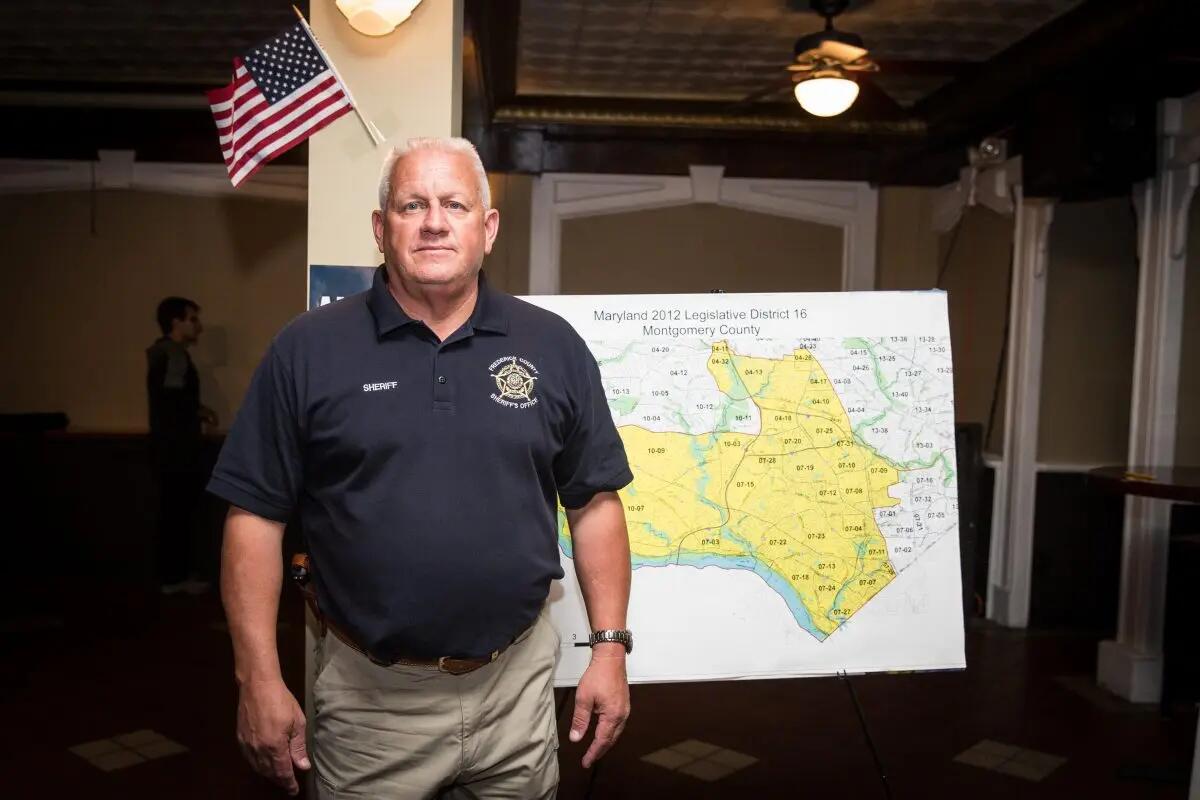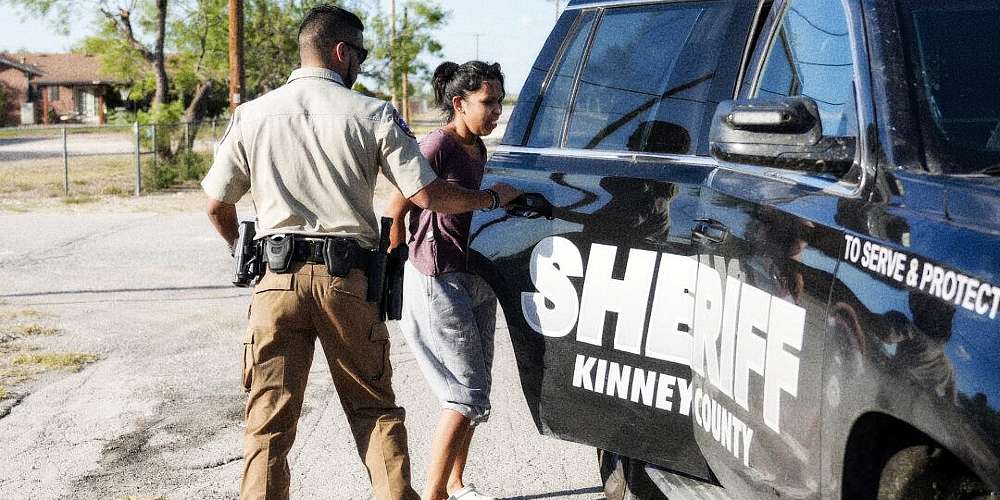(The Epoch Times)—Sheriffs will likely play a key role in helping federal agents secure the border and deport illegal immigrants under President-elect Donald Trump.
Trump made mass deportation of illegal immigrants a key part of his campaign to win a second term as almost 11 million people flooded into the country illegally since 2021.
The president-elect’s incoming border czar, Tom Homan, has signaled a new era of federal, state, and local cooperation when it comes to deporting illegal immigrants.
Homan, the former acting head of U.S. Immigration and Customs Enforcement (ICE), indicated he will first target those who have criminal convictions or are wanted for crimes.
“The nation wants a safe country. We’ve had enough crime in this country,” Homan said during a stop at the Texas border in November.
Sheriffs in the nation’s 3,100 counties could play an essential role in helping ICE to identify and detain illegal immigrants, said Sam Bushman, CEO of the Constitutional Sheriffs and Peace Officers Association (CSPOA), a conservative organization that opposes “unconstitutional” government overreach.
As chief law enforcement officers in their counties, elected sheriffs have more latitude than appointed police chiefs. They have authority over criminal investigations, serving warrants, managing county jails, and providing court security within the county.
Bushman foresees cooperation between willing county, state, and federal authorities to deport illegal immigrants, possibly through the creation of a new coordination agency or command center.
“I think that we could create an organization that communicates with this trifecta, and that would be very effective,” he said.
Richard Mack, a former Arizona sheriff and founder of CSPOA, has been in contact with Homan and believes sheriffs will be an integral part of border security and deportation efforts because of their unique understanding of their jurisdictions.
“Who in this country knows their counties better than the sheriff?” he asked.
Because of their local knowledge, sheriffs are in a unique position to help make deportation safer and easier, Mack told The Epoch Times.
Regardless of politics, sheriffs must protect their constituents from crime and criminals, both tied to illegal immigration in terms of drug and human smuggling along with violent gang activity, he said.
Policy experts have suggested that the federal government could deputize local law enforcement under its 287(g) program to aid ICE because the agency likely doesn’t have the manpower to do so alone.
The 287(g) program currently provides a framework of cooperation wherein local jails work with ICE to identify illegal immigrants as they are booked for a crime. ICE and designated local law enforcement can then hold that inmate for up to an additional 48 hours so that ICE can take custody of the inmate.
Homan has touted the program as a safe deportation pipeline, as ICE officers can pick up deportees within the safety of a jail setting, rather than having to organize an operation out in the community.
ICE has about 20,000 employees, including support personnel. ICE’s Enforcement and Removal Operations (ERO) has 6,100 deportation officers and more than 750 enforcement removal assistants who are assigned to 24 field offices, according to an agency website.
Former Chief of the U.S. Border Patrol Rodney Scott, who served under both Trump and Biden, said in a previous interview with The Epoch Times that Trump could expand the 287(g) program to help with deportations, as he did during his first term.
Scott was recently nominated by Trump to serve as the incoming Customs and Border Protection commissioner.
He said the 287(g) program also allows the creation of a task force and hybrid model that would enable local and state law enforcement to arrest illegal immigrants.
In the blue state of Maryland, Frederick County Sheriff Chuck Jenkins, a longtime Republican, recalls when the task force model was operational in 2008.

“We had deputies on the street that could work at the direction of ICE and with ICE to take into custody people who had deportation warrants and so forth,” Jenkins told The Epoch Times.
Reinstating the task force model would help expedite the deportation of criminals in the country illegally, he said.
The Trump administration could also send representatives to local sheriff departments to recruit them to join the program, he said.
“ICE can’t do it alone, or certainly not enough,” Jenkins said. “We need to be a force multiplier for them.”
Tying federal grant money to sheriff department cooperation with ICE would likely convince many to come on board, he said.
Even if sheriffs don’t participate in arresting illegal immigrants, they could help in other ways, such as providing transportation and logistical support and workspace for ICE, he said.
Jenkins said Frederick County’s jail-based detainer program has been successful, resulting in the removal of about 2,000 illegal immigrant criminals in the county.
Under the 287(g) program, sheriff’s office employees are trained to file a detainer and prepare the paperwork under the supervision of ICE in an effort to streamline the process, he said.
San Diego County Sheriff Kelly Martinez, who serves in the nation’s fifth most populous county, has vowed to defy a new county policy to limit cooperation with federal deportation efforts.
Coffee the Christian way: Promised Grounds
Earlier this month, San Diego County supervisors voted to ban its sheriff department from working with ICE on the federal agency’s enforcement of civil immigration laws, including those that allow for deportations.
California law generally prohibits cooperation but makes exceptions for those convicted of certain violent crimes.
Martinez, whose office is nonpartisan but considers herself a Democrat, said she wouldn’t honor the new policy and that the county government doesn’t oversee her office.
“Current state law strikes the right balance between limiting local law enforcement’s cooperation with immigration authorities, ensuring public safety, and building community trust,” Martinez said.
In the blue state of Michigan, Barry County Sheriff Dar Lief said it is important to remove violent criminals from the streets.
“I’m on board with that,” he told The Epoch Times.
Lief echoed the belief of Trump and his surrogates during the presidential campaign that many of the illegal immigrants coming into the country were from prison systems or asylums.
“Nonetheless, our governor here asked residents to take in illegal immigrants,” he said. “Who are you opening up your house to?”
Lief said he warned the citizens of Barry County against taking in illegal immigrants, which Gov. Gretchen Whitmer called “new Americans,” because there was no guarantee they were properly vetted.
Not all blue states or city leaders are against Trump’s deportation plan to remove criminal illegal immigrants.
New York City Mayor Eric Adams met with Homan recently to discuss deporting illegal immigrants who commit violent crimes in the Democrat-run city.
“We will not be a safe haven for those who commit violent acts. We don’t do it for those who are citizens, and we’re not going to do it for those who are undocumented,” Adams said during a press conference.

Adams said law-abiding illegal immigrants are welcome in the city. Still, it was a “terrible mistake” to allow those in the country unlawfully to commit violent crimes repeatedly, especially those associated with gangs.
New York Gov. Kathy Hochul said in November during a press conference that she supports “legal” immigrants, including asylum-seekers, but not criminals here illegally or those committing crimes.
“Someone breaks the law—I‘ll be the first one to call up ICE and say, ’Get them out of here,’” she said.
Homan said blue city officials don’t have to cooperate, but he has repeatedly warned them not to stand in his way.
Homan recently announced he would begin deportations in Chicago, criticizing Chicago Mayor Brandon Johnson and Illinois Gov. J.B. Pritzker for resisting the removal of criminal immigrants.
“If he impedes us, if he knowingly harbors and conceals an illegal alien, I will prosecute him,” Homan said of the Chicago mayor.

Texas Model
Homan said during a visit to the Texas border town of Eagle Pass before Thanksgiving that the state’s operation to stop illegal immigration could become a national model.
He praised Texas Gov. Greg Abbott’s Operation Lone Star, a $10-billion border mission to string razor wire along the border, place buoy barriers in the Rio Grande, help build a border wall, and bus illegal immigrants to sanctuary cities.
The operation consists of Department of Public Safety law enforcement and Texas National Guard members.
The program also focuses on arresting illegal immigrants for trespassing on private ranchland along the border—offering a unique roadmap for how counties could help deport illegal immigrants.
Brent Smith, the county attorney for Kinney County, has plenty of experience dealing with illegal immigrants in his county, which sits along the Texas–Mexico border.
Kinney County has prosecuted the largest number of illegal immigrants for trespass and related misdemeanors under Operation Lone Star.
In 2019 and 2020, the small, rural county dealt with just 254 and 132 misdemeanor cases, respectively, mostly involving U.S. citizens.
The U.S. citizen caseload has remained somewhat constant, but because of illegal immigration, the total number of misdemeanor cases shot up to 6,799 in 2022 and 5,826 in 2023, according to numbers obtained from the county attorney’s office.
Smith told The Epoch Times that trespassing arrests in Kinney County under Operation Lone Star offered valuable lessons on how to run a border security initiative.
At first, funding went to provide law enforcement, but Smith said it became clear that there needed to be more funding for the entire county justice system for prosecutors, public defenders, clerks, and judges to process illegal immigrants charged with trespassing.
“What I foresee is some very strong 287(g) agreements being entered into, and state and local law enforcement actually becoming an arm of the Department of Homeland Security (DHS) immigration enforcement,” he said.

He said that after undergoing a DHS training program, local officers are considered immigration officers under the supervision of an ICE agent.
He pointed to former Maricopa County Sheriff Joe Arpaio, who was known for implementing the 287(g) task force successfully to arrest illegal immigrants in Arizona but came under fire during the Obama administration.
Maricopa County’s 287(g) program was canceled in 2011 after a Department of Justice investigation accused the sheriff of racial profiling.
In 2012, the Obama administration discontinued the task force and hybrid models of the program altogether.
Trump expanded the program in his first term to 150 agreements with local law enforcement and broadened the removal criteria to include misdemeanors.
Under the Biden administration, new 287(g) agreements were paused.
Smith said that once Trump ends the Biden administration’s catch-and-release policy, there will be more “gotaways,” which will require a shift in resources to focus on apprehension instead of processing those claiming asylum.
Money—or the lack of it—will be an essential tool in deportation and border security, he said.
On the state level, he has been discussing a bill with Texas lawmakers that would require sheriffs to apply for 287(g) agreements before receiving state grant funding.
The same principle could be applied to federal grant money for cities such as Chicago, he said.
“How much is your political leanings worth to you? Is it worth $1,000, or $100,000, or $2 million?” he said. “We’re going to find out.”
Five Things New “Preppers” Forget When Getting Ready for Bad Times Ahead
The preparedness community is growing faster than it has in decades. Even during peak times such as Y2K, the economic downturn of 2008, and Covid, the vast majority of Americans made sure they had plenty of toilet paper but didn’t really stockpile anything else.
Things have changed. There’s a growing anxiety in this presidential election year that has prompted more Americans to get prepared for crazy events in the future. Some of it is being driven by fearmongers, but there are valid concerns with the economy, food supply, pharmaceuticals, the energy grid, and mass rioting that have pushed average Americans into “prepper” mode.
There are degrees of preparedness. One does not have to be a full-blown “doomsday prepper” living off-grid in a secure Montana bunker in order to be ahead of the curve. In many ways, preparedness isn’t about being able to perfectly handle every conceivable situation. It’s about being less dependent on government for as long as possible. Those who have proper “preps” will not be waiting for FEMA to distribute emergency supplies to the desperate masses.
Below are five things people new to preparedness (and sometimes even those with experience) often forget as they get ready. All five are common sense notions that do not rely on doomsday in order to be useful. It may be nice to own a tank during the apocalypse but there’s not much you can do with it until things get really crazy. The recommendations below can have places in the lives of average Americans whether doomsday comes or not.
Note: The information provided by this publication or any related communications is for informational purposes only and should not be considered as financial advice. We do not provide personalized investment, financial, or legal advice.
Secured Wealth
Whether in the bank or held in a retirement account, most Americans feel that their life’s savings is relatively secure. At least they did until the last couple of years when de-banking, geopolitical turmoil, and the threat of Central Bank Digital Currencies reared their ugly heads.
It behooves Americans to diversify their holdings. If there’s a triggering event or series of events that cripple the financial systems or devalue the U.S. Dollar, wealth can evaporate quickly. To hedge against potential turmoil, many Americans are looking in two directions: Crypto and physical precious metals.
There are huge advantages to cryptocurrencies, but there are also inherent risks because “virtual” money can become challenging to spend. Add in the push by central banks and governments to regulate or even replace cryptocurrencies with their own versions they control and the risks amplify. There’s nothing wrong with cryptocurrencies today but things can change rapidly.
As for physical precious metals, many Americans pay cash to keep plenty on hand in their safe. Rolling over or transferring retirement accounts into self-directed IRAs is also a popular option, but there are caveats. It can often take weeks or even months to get the gold and silver shipped if the owner chooses to close their account. This is why Genesis Gold Group stands out. Their relationship with the depositories allows for rapid closure and shipping, often in less than 10 days from the time the account holder makes their move. This can come in handy if things appear to be heading south.
Lots of Potable Water
One of the biggest shocks that hit new preppers is understanding how much potable water they need in order to survive. Experts claim one gallon of water per person per day is necessary. Even the most conservative estimates put it at over half-a-gallon. That means that for a family of four, they’ll need around 120 gallons of water to survive for a month if the taps turn off and the stores empty out.
Being near a fresh water source, whether it’s a river, lake, or well, is a best practice among experienced preppers. It’s necessary to have a water filter as well, even if the taps are still working. Many refuse to drink tap water even when there is no emergency. Berkey was our previous favorite but they’re under attack from regulators so the Alexapure systems are solid replacements.
For those in the city or away from fresh water sources, storage is the best option. This can be challenging because proper water storage containers take up a lot of room and are difficult to move if the need arises. For “bug in” situations, having a larger container that stores hundreds or even thousands of gallons is better than stacking 1-5 gallon containers. Unfortunately, they won’t be easily transportable and they can cost a lot to install.
Water is critical. If chaos erupts and water infrastructure is compromised, having a large backup supply can be lifesaving.
Pharmaceuticals and Medical Supplies
There are multiple threats specific to the medical supply chain. With Chinese and Indian imports accounting for over 90% of pharmaceutical ingredients in the United States, deteriorating relations could make it impossible to get the medicines and antibiotics many of us need.
Stocking up many prescription medications can be hard. Doctors generally do not like to prescribe large batches of drugs even if they are shelf-stable for extended periods of time. It is a best practice to ask your doctor if they can prescribe a larger amount. Today, some are sympathetic to concerns about pharmacies running out or becoming inaccessible. Tell them your concerns. It’s worth a shot. The worst they can do is say no.
If your doctor is unwilling to help you stock up on medicines, then Jase Medical is a good alternative. Through telehealth, they can prescribe daily meds or antibiotics that are shipped to your door. As proponents of medical freedom, they empathize with those who want to have enough medical supplies on hand in case things go wrong.
Energy Sources
The vast majority of Americans are locked into the grid. This has proven to be a massive liability when the grid goes down. Unfortunately, there are no inexpensive remedies.
Those living off-grid had to either spend a lot of money or effort (or both) to get their alternative energy sources like solar set up. For those who do not want to go so far, it’s still a best practice to have backup power sources. Diesel generators and portable solar panels are the two most popular, and while they’re not inexpensive they are not out of reach of most Americans who are concerned about being without power for extended periods of time.
Natural gas is another necessity for many, but that’s far more challenging to replace. Having alternatives for heating and cooking that can be powered if gas and electric grids go down is important. Have a backup for items that require power such as manual can openers. If you’re stuck eating canned foods for a while and all you have is an electric opener, you’ll have problems.
Don’t Forget the Protein
When most think about “prepping,” they think about their food supply. More Americans are turning to gardening and homesteading as ways to produce their own food. Others are working with local farmers and ranchers to purchase directly from the sources. This is a good idea whether doomsday comes or not, but it’s particularly important if the food supply chain is broken.
Most grocery stores have about one to two weeks worth of food, as do most American households. Grocers rely heavily on truckers to receive their ongoing shipments. In a crisis, the current process can fail. It behooves Americans for multiple reasons to localize their food purchases as much as possible.
Long-term storage is another popular option. Canned foods, MREs, and freeze dried meals are selling out quickly even as prices rise. But one component that is conspicuously absent in shelf-stable food is high-quality protein. Most survival food companies offer low quality “protein buckets” or cans of meat, but they are often barely edible.
Prepper All-Naturals offers premium cuts of steak that have been cooked sous vide and freeze dried to give them a 25-year shelf life. They offer Ribeye, NY Strip, and Tenderloin among others.
Having buckets of beans and rice is a good start, but keeping a solid supply of high-quality protein isn’t just healthier. It can help a family maintain normalcy through crises.
Prepare Without Fear
With all the challenges we face as Americans today, it can be emotionally draining. Citizens are scared and there’s nothing irrational about their concerns. Being prepared and making lifestyle changes to secure necessities can go a long way toward overcoming the fears that plague us. We should hope and pray for the best but prepare for the worst. And if the worst does come, then knowing we did what we could to be ready for it will help us face those challenges with confidence.



